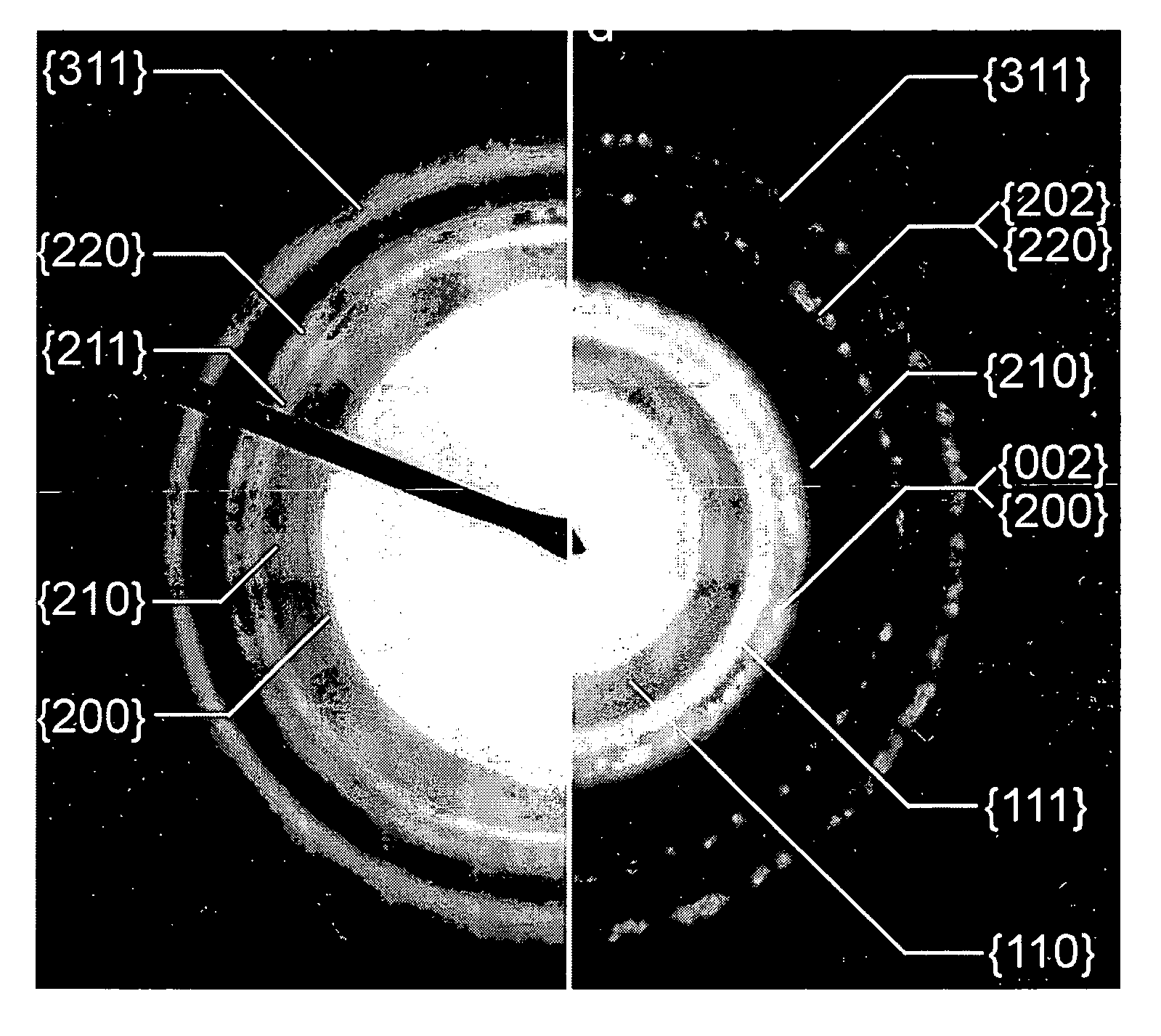Core-shell magnetic nanoparticles and nanocomposite materials formed therefrom
a technology of magnetic nanoparticles and composite materials, which is applied in the direction of magnetic materials, magnetic bodies, transportation and packaging, etc., to achieve the effects of increasing surface pressure, high compressing pressure, and reducing void spaces
- Summary
- Abstract
- Description
- Claims
- Application Information
AI Technical Summary
Benefits of technology
Problems solved by technology
Method used
Image
Examples
example 1
Synthesis of Face-Centered Tetragonal (fct) FePt in Film and Bulk Forms from Pt@Fe2O3 Core-Shell Particles (10 nm Pt Core and ˜3.5 nm Fe2O3 Shell) at 550° C.
[0117]Obtaining Pt@Fe2O3 core-shell particles. A mixture of 1,2-hexadecanediol (200 mg), octyl ether (2.5 mL), oleic acid (120 μL) and oleylamine (80 μL) was added to a 15 mL three-neck round-bottle flask under argon protection. The resulting solution was heated to 290° C. at a rate of 5° C. / min and refluxed at this temperature. 100 mg platinum acetylacetonate and 1 mL octyl ether mixture were quickly injected into the reaction solution. The solution began to turn black indicating the formation of Pt nanoparticles. The solution was kept at reflux temperature for 10 minutes, then cooled to 150° C. when 55 μL Fe(CO)5 were slowly injected into the solution. After injecting Fe(CO)5, the solution was heated to reflux temperature and maintained at reflux temperature for 30 minutes. After the reaction, size selection separation was per...
example 2
Synthesis of Face-Centered Tetragonal (fct) FePt in Film and Bulk Forms from Pt@Fe2O3 Core-Shell Particles (10 nm Pt Core and ˜3.5 nm Fe2O3 Shell) at 650° C.
[0120]Pt@Fe2O3 core-shell particles were obtained by the procedure described in Example 1.
[0121]0.5 mL concentrated Pt@Fe2O3 particles in a 10 mg / mL hexane solution were slowly drop-cast onto a Si wafer under a fume hood. Hexane was allowed to evaporate. The wafer was then transferred into a tube furnace to anneal under a flow of H2 (5 v / v %) in Ar gas at 550° C. for 2 hours. The annealing was conducted by preheating at room temperature for 10 minutes, heating to 350° C. at a rate of 150° C. / h and maintaining temperature for 2 hours, heating to 650° C. at a rate of 100° C. / h and maintaining at 650° C. for 2 hours, and cooling naturally to room temperature.
[0122]Powder X-ray Diffraction (XRD), Energy-dispersive X-ray (EDX) and SQUID were performed to characterize the fct FePt in film and bulk forms. FIG. 14(a) shows XRD analysis ...
example 3
Synthesis of Face-Centered Cubic (fcc) Fe3Pt in Film and Bulk Forms from Pt@Fe2O3 Core-Shell Particles (10 nm Pt Core and ˜4 nm Fe2O3 Shell) at 550° C.
[0123]Pt@Fe2O3 core-shell nanoparticles as precursors were obtained by the procedure described in Example 1, except that 75 μL of Fe(CO)5 were used. Pt@Fe2O3 core-shell particles were converted into fcc Fe3Pt in film and bulk forms by the procedure described in Example 1.
[0124]Powder X-ray Diffraction (XRD), Energy-Dispersive X-ray (EDX) and SQUID were used to characterize the samples in film and bulk forms. FIG. 15(a) shows XRD analysis of the resulting film. The XRD analysis shows that the granular film is the fcc phase of Fe3Pt. FIG. 15(b) shows SQUID analysis of the resulting film. SQUID analysis shows that the ferromagnetic character of the fcc Fe3Pt film and bulk forms has a coercivity of 1 KOe measured at 5 Kelvin. The composition was confirmed to have an atomic ratio of Fe72Pt28 by EDX analysis.
PUM
| Property | Measurement | Unit |
|---|---|---|
| temperature | aaaaa | aaaaa |
| temperature | aaaaa | aaaaa |
| core diameter | aaaaa | aaaaa |
Abstract
Description
Claims
Application Information
 Login to View More
Login to View More - R&D
- Intellectual Property
- Life Sciences
- Materials
- Tech Scout
- Unparalleled Data Quality
- Higher Quality Content
- 60% Fewer Hallucinations
Browse by: Latest US Patents, China's latest patents, Technical Efficacy Thesaurus, Application Domain, Technology Topic, Popular Technical Reports.
© 2025 PatSnap. All rights reserved.Legal|Privacy policy|Modern Slavery Act Transparency Statement|Sitemap|About US| Contact US: help@patsnap.com



